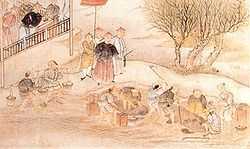Xiangcheng District, Zhangzhou
| Xiangcheng District 芗城区 | |
|---|---|
| District | |
 Xiangcheng | |
| Coordinates: 24°30′41″N 117°39′15″E / 24.51139°N 117.65417°ECoordinates: 24°30′41″N 117°39′15″E / 24.51139°N 117.65417°E | |
| Country | People's Republic of China |
| Province | Fujian |
| Prefecture-level city | Zhangzhou |
| Time zone | China Standard (UTC+8) |
Xiangcheng District (simplified Chinese: 芗城区; traditional Chinese: 薌城區; pinyin: Xiāngchéng qū; Pe̍h-ōe-jī: Hiang-sêng-khu), or Sin Kang District in Min Nan, is a district of Zhangzhou, Fujian province, People's Republic of China.
Location
Xiangcheng is surrounded by the Chuan Chiam Boey Mountains in the south, a bay in the north, the Khor Chu Village in the east, and the Hui Chor Village in the west, where the clan village residents with the surname Qiū (邱) are the majority.
Xiangcheng was developed as a clan village with specific surnames for more than 600 years since the Ming Dynasty, with various small communities settled within the clan were formed. Clusters of houses with red-tiled roofs scatter among the labyrinthine alleys, and westward, in the near mid-west of the village, the main street runs from north to south. In the middle part of it stands the marketplace. Xiangcheng is the second place where dominated by 邱 (Qiū, Khoo in Hokkien) surnames settlers, and the second is Penang, Malaysia.
The village has thirteen ancestral halls of different sizes, each representing a branch of the Qiu clan. There are two main temples in the village, namely the Cheng Soon Keong and the Hock Leng Keong. The former enshrines Ong Soon Yah and Tua Sai Yah, the patron saints of the Qiu clan, while the latter houses Poh Seh Tai Tay (保生大帝), the God of Medicine.
Landmarks
The original Cheng Soon Keong temple collapsed due to lack of maintenance during the Cultural Revolution (1966~1976). The present building was rebuilt in 1997 with a donation of US$0.84 million from Leong San Tong Khoo Kongsi, Penang. Situated at the downstream of Jiulong River, Xiangcheng was near the trading ports of Southern China from where people of Southern Fujian went overseas during the Ming and Qing Dynasties.
In 1567, Yuegang (月港), a new port which was located about 22 kilometres (14 mi) from Xiangjiang, replaced Zhangzhou as the major port in Southern Fujian. Guek Kang was then superseded by Amoy during the Qing dynasty.

After the 1842 Opium War, Amoy was declared as one of the five treaty ports. Since the 1920s, it has been an important international trading port of China. People in this area were good seafarers. They had been keeping in touch with foreign traders since the imperial government. Migration was a common practice among them during the heyday.
References
| |||||||||||||||||||||||||||||||||||||||
| |||||||||||||||||||||||||||||||||||||||